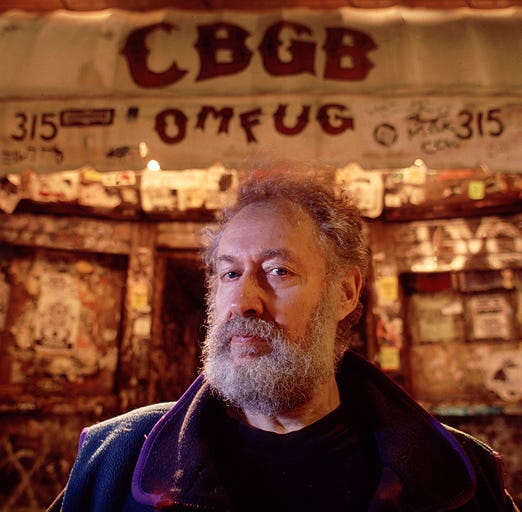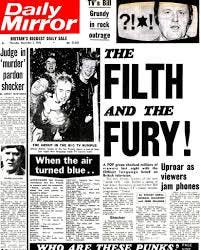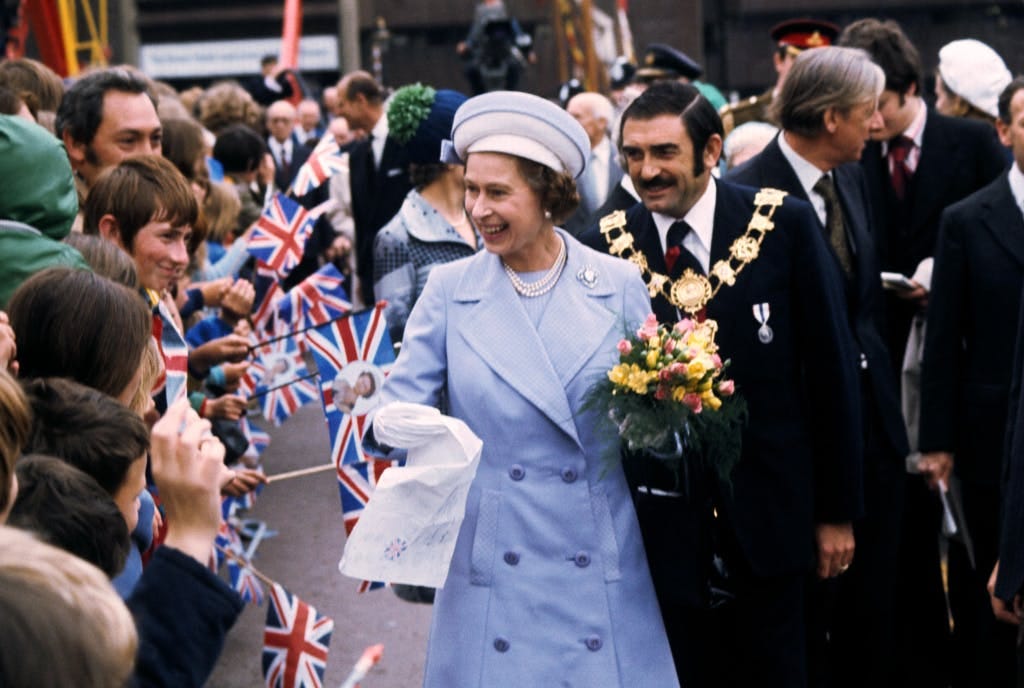CBGB: from Punk to Post-Punk
"CBGB represents a lot to New York City and to underground rock and to new wave and post-punk and whatever. You know, it's like tearing down the Jefferson Memorial or something." - Dave Grohl
CBGB & OMFUG
The Manhattan club, Country, Bluegrass, Blues, and Other Music For Uplifting Gormandizers, was better known as CBGB. It opened in 1973 by Hilly Kristal:
As the name suggests, the venue was intended to be a country club, for hungry, hungry patrons, in the Bowery District.
Gromandizer: One who eats greedily or too much. Example: An inconsiderate gormandizer who eats his hosts out of house and home. (Yes, I had to look that up.)
But the venue and the neighborhood didn’t quite align with the vision. It was a bit too punk for that.
New York City was a very different place.
NYC was in economic decline, fueling (and fueled by) a flight to the suburbs. The city government was on the verge of bankruptcy. Crime and drug use was rampant.
But rents were cheap! And art scenes love cheap rent.
Cover Bands vs. Original Music
Then (as now), cover bands were hugely popular, drawing crowds to hear the hits, for a cheap cover and cheaper drinks.
But in U.S. copyright law, cover music is considered a public performance of a copyrighted work, requiring royalties to be paid to the rights holders. That was expensive. And Hilly was broke.
So he got local bands to play their original music at CBGB, circumventing the rules. The time and place had an ethos that attracted groups who were willing to play on the bleeding edge. Outcasts, rebels, scenesters, revolutionaries.
Punks.
The First Punk Bands: The Dictators and The Ramones
I had the honor of sitting down with Andy Shernoff, one of the pioneers of the scene. This video podcast episode is worth another 100,000 words, and he describes the reality far better than I ever could:
And now it’s time for some music!
The Dictators
The Ramones
Alternative Media: Zines
Zines (short for "magazines" or "fanzines") are self-published, small-circulation booklets or magazines that became a vital part of the underground scene. They were DIY, rule breaking, niche, and radical. They were also handed out at concerts, record stores, and other watering holes for radicals and outcasts.
Zines were building off of the tradition of communist manifestos and the Beatniks’ self-published poetry. The Punks took it to a new level, rejecting commercialism, leaning into the raw, and breaking with the traditional culture.
These zines were also responding to the economic collapse of NYC and 1970’s London with their own, punk response: Anarchy.
So punk had its venue: CBGB; it’s audience: the economically depressed youth (with cheap rent!); and it’s message: anarchy and rebellion without a cause. Each informed the music in turn.
Bonus bit: Zines in the future would help organize and unite LGBTQ+ communities, feminist punk rockers (Riot Grrrls), and other alternative political thinkers, exercising their free speech and free thinking to decry capitalism and promote environmentalism, mysticism, or other outside-of-mainstream modes of advocacy.
NYC was the spark. London was the explosion.
On the last eleven History of Rock posts, we’ve covered the turn to the theatrical, and in a crowded NYC scene, punk was no exception. Bands were fighting to build their noticeability and followings, and therefore, their pay at the end of the night. That competitive environment helped to create the New York Dolls, a proto-punk band that helped inspire the glam scene, including Twisted Sister. Malcolm McLaren managed them for a time in 1974, before returning to London to try and kickstart the British punk scene.
On his return, mastermind Malcolm McLaren started a clothing store with Vivienne Westwood named SEX Boutique, designing and defining the punk fashion that endures to this day, turning safety pins, leather, and provocative slogans into an aesthetic. The shop served as a hub for London’s burgeoning punk community and helped define the movement’s visual identity.
Malcolm also shared punk zines and recordings with a select set of local musicians who characterized the culture’s irreverent attitude, and recruited them to start a new band: The Sex Pistols.
The band was Glen Matlock (Bass) — a former worker at the SEX Boutique —childhood friends Steve Jones (Guitar) and Paul Cook (Drums), and Johnny Rotten (Vocals, born John Lydon), who was scouted by Malcolm and auditioned by singing Alice Cooper. In 1977, Sid Vicious (born John Ritchie) would take over for Glen on bass.
The Punk Attitude: The Grundy Show Incident
Malcom realized that a hard edge sells. His approach to promote the band became undeniable when he got them a last-minute opportunity to interview on a famous television show, filling in for Queen because Freddy Mercury had a toothache.
The Pistols joined the show live, and shocked the nation by swearing live on television. Explicit language warning, of course, viewer beware!
Rock ‘n’ roll:
The tabloid press went crazy. Turning The Sex Pistols into household names.
Let’s Do It Again
The Queen was celebrating her 25th year of rule, with the Silver Jubilee:
And Malcolm had an idea… ruin it.
He rented a barge (hilariously named the Queen Elizabeth) and had it sail down the River Thames, right by the celebration. The Pistols would perform their latest single, God Save the Queen, full blast rolling down the river.
The police stormed the boat, clashing with the crew, and creating another media blitz. The single was banned by BBC, but despite (or because of that) hit #2 on the charts.
There’s more. If you’re intrigued, I’d invite you to read the short, depressing history of Sid Vicious.
As Malcolm said, “The Pistols weren’t meant to last. They were meant to explode.”
Speaking of The Clash
Emerging from this punk chaos, The Clash brought grit, urgency, and substance to the scene, wielding their music like a weapon, and writing about racism, unemployment, and imperialism. They blended in reggae, ska, and rockabilly, revealing punk’s potential for longevity and sub-genres. In other words, they were the bridge from the brash beginnings to a global phenomenon that endures to this day.
Give a listen to “the only band that matters:”
The Velvet Underground: Art, Experimentation, and the Roots of Alternative Rock
The Velvet Underground was formed in New York City in 1964, so waaaaay before the punk revolution we’ve been discussing. But their influence on the genre (and the second wave of post-punk) can’t be overstated.
The band was born out of the collaboration between songwriter/guitarist Lou Reed and avant-garde musician John Cale. Reed, a staff songwriter for Pickwick Records, met Cale, a classically trained viola player, after Reed’s experimental track caught Cale’s ear. Together, they fused Reed’s gritty, streetwise lyricism with Cale’s avant-garde influences, recruiting guitarist Sterling Morrison and drummer Maureen “Moe” Tucker, whose minimalist drumming would help define the band’s sound. The band’s trajectory shifted dramatically when they were introduced to super-famous-artist-dude Andy Warhol, who became their manager and incorporated them into his multimedia art collective, The Factory.
Their 1967 debut album, The Velvet Underground & Nico, featured Nico, a German model and chanteuse, and blended raw rock with experimental dissonance and taboo lyrics. Their rracks like Heroin, I’m Waiting for the Man, and Venus in Furs tackled subjects like drug addiction and BDSM with a stark honesty. The raw edge and avant-garde instrumentation (like Cale’s droning viola) led the record to flop commercially.
Brian Eno famously said while only a few thousand people bought their debut album, “everyone who bought it started a band.”
Post-Punk: Back to CBGB
Punk’s arc was similar to early rock. There was an initial burst of raw energy, which led to scandal and untimely deaths, and finally to a more introspective version of the initial genre. The post-punk music that emerged yet again at CBGB followed this pattern. (You can see similar phenomenons in metal, emo, etc.)
Stop Making Sense!
Was punk a sound? An aesthetic? A mindset?
The Talking Heads offered a dadaist non-answer, and became the quintessential CBGB band for this new era. David Byrne’s jittery, neurotic delivery and the band’s experimentation with Afrobeat and funk showed how expansive punk's offshoots could be.
Punk vs. Disco?
Blondie’s roots were pure punk, opening for The Ramones in the early days, but they had a pop sensibility that catapulted them to stardom in 1978, with hits like, “One Way or Another.” They also absorbed some of the dominant genre at the time: disco.
Joy Division
Back in Manchester, England, Joy Division turned punk’s angst inward, capturing the despair with an atmospheric distillation that would become timelessly fashionable.
Keanu Reeves said he could listen to this song exclusively for the rest of his life:
Alternative Rock or Punk?
There’s a through-line between these post-punk acts and the contemporary genre of “Alt Rock.”
A prime example of this lineage is The Cure from the late 70s. Their debut album, Three Imaginary Boys (1979), was raw and minimalist, closer to a punk origin. But then they bounced between gothic, dark, sorrowful songs and pop bops like this one:
Eras churn and tastes shift, and Rock sub-genres are no exception to this cyclical occurrence. CBGB was also absorbed by the tides of change, closing on October 15, 2006 after a 3.5 hour final concert by Patti Smith:
Thanks for reading internet friends,
Scoob
P.S. My new LP is a great holiday gift, and it’s a fantastic way to support this Substack and music! Learn more and get your copy now!
Also also keep up with all the things Love Music More by subscribing to the companion podcast. The Doing More with Less (Art and Grit) episode is a relevant place to start after our recent excursion through the punk way of making something with whatever’s available. 🧷












Learning about the substantial impact that magazines and the media have had on the rock genre captivated me. Finding out how important the Sex Pistols were in influencing rock music was also fascinating. Their distinct aesthetic and defiant demeanor were especially remarkable. This makes me question: what other bands, like the Sex Pistols, have had a significant influence on a certain genre?
I loved learning about English History and how music was influenced there and how big of a role music played in that era. Its cool to learn how other places have influenced music and the different genres exposed. Its cool to know how much music can change other peoples opinions and perspectives how the song about Queen Elizabeth's did. Which i think is a great example of how punk rock has such an impact on society.